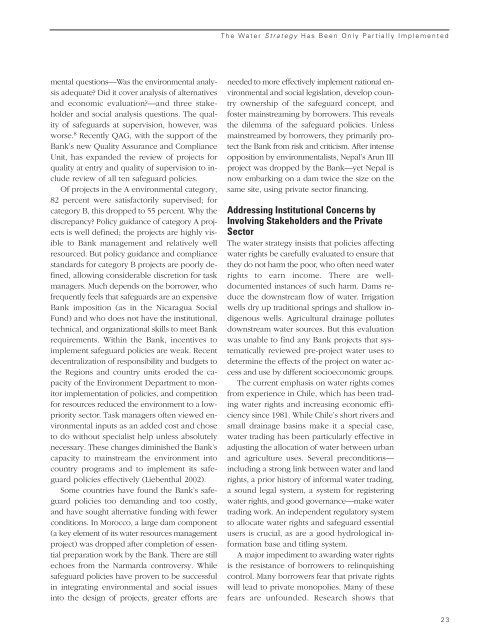Download Report - Independent Evaluation Group - World Bank
Download Report - Independent Evaluation Group - World Bank
Download Report - Independent Evaluation Group - World Bank
Create successful ePaper yourself
Turn your PDF publications into a flip-book with our unique Google optimized e-Paper software.
The Water Strategy Has Been Only Partially Implementedmental questions—Was the environmental analysisadequate? Did it cover analysis of alternativesand economic evaluation?—and three stakeholderand social analysis questions. The qualityof safeguards at supervision, however, wasworse. 8 Recently QAG, with the support of the<strong>Bank</strong>’s new Quality Assurance and ComplianceUnit, has expanded the review of projects forquality at entry and quality of supervision to includereview of all ten safeguard policies.Of projects in the A environmental category,82 percent were satisfactorily supervised; forcategory B, this dropped to 55 percent. Why thediscrepancy? Policy guidance of category A projectsis well defined; the projects are highly visibleto <strong>Bank</strong> management and relatively wellresourced. But policy guidance and compliancestandards for category B projects are poorly defined,allowing considerable discretion for taskmanagers. Much depends on the borrower, whofrequently feels that safeguards are an expensive<strong>Bank</strong> imposition (as in the Nicaragua SocialFund) and who does not have the institutional,technical, and organizational skills to meet <strong>Bank</strong>requirements. Within the <strong>Bank</strong>, incentives toimplement safeguard policies are weak. Recentdecentralization of responsibility and budgets tothe Regions and country units eroded the capacityof the Environment Department to monitorimplementation of policies, and competitionfor resources reduced the environment to a lowprioritysector. Task managers often viewed environmentalinputs as an added cost and choseto do without specialist help unless absolutelynecessary. These changes diminished the <strong>Bank</strong>’scapacity to mainstream the environment intocountry programs and to implement its safeguardpolicies effectively (Liebenthal 2002).Some countries have found the <strong>Bank</strong>’s safeguardpolicies too demanding and too costly,and have sought alternative funding with fewerconditions. In Morocco, a large dam component(a key element of its water resources managementproject) was dropped after completion of essentialpreparation work by the <strong>Bank</strong>. There are stillechoes from the Narmarda controversy. Whilesafeguard policies have proven to be successfulin integrating environmental and social issuesinto the design of projects, greater efforts areneeded to more effectively implement national environmentaland social legislation, develop countryownership of the safeguard concept, andfoster mainstreaming by borrowers. This revealsthe dilemma of the safeguard policies. Unlessmainstreamed by borrowers, they primarily protectthe <strong>Bank</strong> from risk and criticism. After intenseopposition by environmentalists, Nepal’s Arun IIIproject was dropped by the <strong>Bank</strong>—yet Nepal isnow embarking on a dam twice the size on thesame site, using private sector financing.Addressing Institutional Concerns byInvolving Stakeholders and the PrivateSectorThe water strategy insists that policies affectingwater rights be carefully evaluated to ensure thatthey do not harm the poor, who often need waterrights to earn income. There are welldocumentedinstances of such harm. Dams reducethe downstream flow of water. Irrigationwells dry up traditional springs and shallow indigenouswells. Agricultural drainage pollutesdownstream water sources. But this evaluationwas unable to find any <strong>Bank</strong> projects that systematicallyreviewed pre-project water uses todetermine the effects of the project on water accessand use by different socioeconomic groups.The current emphasis on water rights comesfrom experience in Chile, which has been tradingwater rights and increasing economic efficiencysince 1981. While Chile’s short rivers andsmall drainage basins make it a special case,water trading has been particularly effective inadjusting the allocation of water between urbanand agriculture uses. Several preconditions—including a strong link between water and landrights, a prior history of informal water trading,a sound legal system, a system for registeringwater rights, and good governance—make watertrading work. An independent regulatory systemto allocate water rights and safeguard essentialusers is crucial, as are a good hydrological informationbase and titling system.A major impediment to awarding water rightsis the resistance of borrowers to relinquishingcontrol. Many borrowers fear that private rightswill lead to private monopolies. Many of thesefears are unfounded. Research shows that23
















